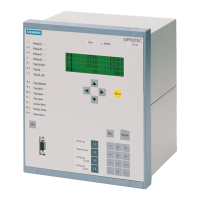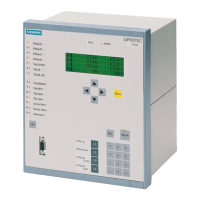Functions
2.21 Undervoltage Protection (ANSI 27)
SIPROTEC, 7UM62, Manual
C53000-G1176-C149-7, Release date 03.2010
175
2.21 Undervoltage Protection (ANSI 27)
The undervoltage protection function detects voltage dips on electrical machines and prevents inadmissible op-
erating states and a possible loss of stability. Two-pole short circuits or ground faults cause a dip in asymmet-
rical voltages. Compared to three single-phase measuring systems, the detection of the positive phase-se-
quence system is not influenced by these procedures and is particularly advantageous for assessing stability
problems.
2.21.1 Functional Description
Mode of Operation
For the above reasons, the positive sequence system is calculated from the fundamental waves of the three
phase-earth voltages, and fed to the protection function.
Undervoltage protection consists of two stages. A pickup is signalled as soon as selectable voltage thresholds
are undershot. A trip signal is transmitted if a voltage pickup exists for a selectable time.
In order to ensure that the protection does not accidentally pick up due to a secondary voltage failure, each
stage can be blocked individually or both stages together, via binary input(s), e.g. using a voltage transformer
mcb. Also the integrated Fuse-Failure Monitor will block the two stages (see Section 2.42.1).
If a pickup occurs as the device changes to operational condition 0 - i.e. no usable measured quantities are
present or the admissible frequency range has been exited - this pickup is maintained. This ensures tripping
even under such conditions. This seal-in can be retracted only after the measured value has reverted to a value
above the drop-off value or by activation of the blocking input.
If no pickup exists before the device is in operating status 0 (thus e.g. on switchon of the device without avail-
able measured values), no pickup and no tripping will occur. An immediate tripping may ensue on transition to
operating status 1 (i.e. by application of measured values). For this reason it is recommended that the blocking
input of the undervoltage protection is activated via the circuit breaker auxiliary contact, thus, for example,
blocking the protection function after a protective tripping.
The following figure shows the logic diagram for undervoltage protection.

